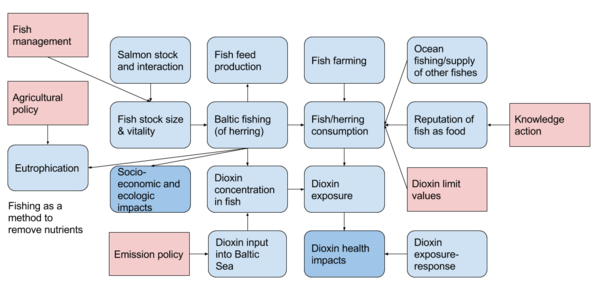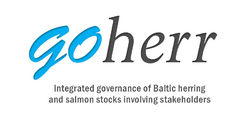Goherr: WP6 Building a decision support model for integrated governance
Causal diagram
Research questions related to the nodes of the diagram (typically refers especially to Baltic herring, but also to other fish species):
Decisions:
- Fish management: What decision options should be considered for manipulating stocks of fish species in the Baltic Sea?
- Agricultural policy: What agricultural policies should be considered for reducing nutrient flows to the Baltic Sea?
- Emission policy: What emission policies should be considered to limit the emissions of dioxins in Northern Europe?
- Dioxin limit value: What limit values should be used for fish and feed to reduce the exposures of humans and domestic animals to dioxins in such a way that the use of fish is limited as little as possible without introducing health risks of too high levels?
- Knowledge action: What public recommendations and knowledge campaigns should be introduced to promote public health and socioeconomic and ecologic impacts?
Objectives:
- Dioxin health impacts: What are the health impacts of dioxins from fish in Finland, Sweden, Denmark, and Estonia?
- Socioeconomic and ecologic impacts: What are the socioeconomic (e.g. income from selling, labour impacts, recreational values,...) and ecologic (eutrophication, sustainability of fish stocks,...) impacts of the fishing of Baltic herring?
Other variables:
- Salmon stock and interaction: What is the size and quality of the salmon stock in the Baltic Sea in 2015-2040? How does it interact with the Baltic herring stock?
- Fish stock size & vitality: What is the size and vitality of the Baltic herring stock in the Baltic sea in 2015-2040?
- Fish feed production: What is the amount of fish feed (fish meal, fish oil) produced from the fish of the Baltic Sea? What species are used and what are the dioxin concentrations before/after a possible purification process?
- Baltic fishing (of herring): What is the amount of fishing of Baltic herring in 2015-2040 in different countries?
- Fish farming: What is the amount of fish farming in the world and especially Baltic Sea?
- Fish/herring consumption: What is the amount of fish consumed (categorised by species) around the Baltic Sea in 2015-2040 in different countries?
- Ocean fishing/supply of other fishes: What is the amount of fishing in other parts of the world, relative to a global demand?
- Reputation of fish as food: What are the mental associations attached to different fish species, and how do these affect the consumption of the fish?
- Eutrophication: What is the level of eutrophication in different areas of the Baltic Sea in 2015-2040?
- Dioxin input into Baltic Sea: What are the inputs of dioxin into the water ecosystem of the Baltic Sea from the air (deposition), rivers (transport), and sediments (resuspension)?
- Dioxin concentration in fish: What are dioxin, PCB, and methylmercury concentrations in different fish species from the Baltic Sea in 2015-2040?
- Dioxin exposure: What is the dioxin, PCB, and methylmercury exposure from fish in different population groups in Finland, Sweden, Denmark, and Estonia?
- Dioxin exposure-response: What are the exposure-response functions of dioxin, PCB, and methylmercury on several health responses in humans.
Questions for the first workshop
Fishery
1. Long-term prospects of herring/fish fishing and changes in global market. What happens when ocean stocks fall? (Herring as feed vs herring as human food).
- How herring market/use might change in the future (2040)? (identify 3 alternative ways)
- What factors affect? Identify 5 most important.
- What would be the most desirable future? Why? What would be the social/economic/ecological impacts?
- How to reach the most desirable future? Identify 5 ways/means/measures.
- What would be the most undesirable state of future? Why? What would be the social/economic/ecological impacts?
- How to avoid the most undesirable future?
2. Implications of (changes in?) dioxin to fishing sector - what if dioxin decreases? What if herring gets a MSC certificate?
- How would herring fishing industry change if dioxin decreased to a “safe” level? Identify 5 changes.
- What might be the 3 most important social, economic and ecological impacts of these changes at the local/regional/global level?
- Identify objective(s) for the development of fishing sector (e.g. improve economic value of fish)
- How to reach the objective(s)?
Health
3. Dioxin risk: EU regulations and national policies and recommendations on dioxin and herring differ remarkably: Why? How do you see this difference? Who is right?Dioxin risks as a social construct, Swedish vs Finnish policies about fish farming/dioxin policy---EU regulations about health risks vs health benefits. - What is the impact of Estonian lack of limit value? Comparison of situations between countries (preliminary in the workshop, more detailed later).,Herring in Media
- Identify 5 reasons why Finnish/Swedish/EU regulations and recommendations on herring intake differ from each other?
- Who is right? (=What is the risk?)
- How should the dioxin risk be managed? Identify 5 best practices (existing or new).
- How might these best practices affect? Identify 5 social/economic/ecological/health effects.
- Identify objective(s) for dioxin risk management (e.g. decrease uncertainty, minimise dioxin)
- How to reach the objective(s)?
4. Discussion about (and testing of) the consumer survey. Impact of dioxin to herring consumption (vs. other factors)- Dioxin as one determinant of reputation of herring. Disadvantages of dioxin to the image of herring
- Identify 10 factors that influence consumers’ fish eating
- Do people avoid herring because of dioxin?
- Identify 5 ways to increase the use of herring for food.
- How should consumers be informed about the health effects of Baltic herring? List 5 best practices.
- Identify objective(s) for herring consumption (e.g. human consumption increases)
- How to reach the objective(s)?
WP plan
Objectives of WP
Holistic decision analysis of Baltic salmon and herring fisheries and management measures aiming at social, biological, and health-related utilities
Description of work, tasks, and role of participants
Based on 1) the analysis of integrated ecosystem-based governance (WP2), 2) biological dynamics between salmon and herring stocks and the link of this to dioxin concentration (WP4), 3) Benefit-risk assessment of previous, current and future fish intake (WP5), 4) Definitions of management aims (WP3), and 5) Future scenarios for the use of Baltic herring and salmon, dioxin input, and eutrophication (WP3), a holistic Bayesian decision support model will be built for the integrated governance of Baltic salmon and herring. The model will be used to analyze the impact of salmon and herring and their management on each other, on the dioxin concentration and on human health under different scenarios, and the impact of the different management options on these. The management options that will be incorporated in the model relate to a) reducing dioxin in salmon and herring, b) sustainable use of salmon and herring, c) reducing eutrophication, d) guiding the consumption of salmon and herring, could benefit the society in terms of reduced dioxin in fish while at the same time ensuring sustainable catches for both species. Importantly, the model will be used to analyse fishers’ commitment to the decision options that relate to fishing.
Moreover, as the core question of the whole project, the decision support tool will be used to analyse the success of different types of governance structures in implementing ecosystem based management, and the consequences of them from the perspective of decisions. Alternatives for the governance structures will be developed in WP2, focusing on policy dynamics and networking between sectoral, regional, national and subnational levels, and stakeholder/consumer interests. It will also be analysed which is the most beneficial governance level to involve stakeholders, if the aim is to enhance fishers’ commitment to management decisions.
The tool enables an integrated risk analysis for examining biological, cultural, and governance-related uncertainties in relation to biological, social and governance-related utilities. A value-of-Information (VOI)analysis will be realized to propose priorities of research for policy, and a value-of-control (VOC) analysis to find out the most beneficial ways to control the system.
Task 6.1 Building the structure of the decision support model (UH, THL, UOULU, SLU) (Month16)
The preliminary model structure for the integrated Bayesian influence diagram will be specified will be built as a scientific desk work, in collaboration with other WPs. It will be presented in the International Workshop No 1, discussed, and modified according to stakeholders’ feedback. Thereby, building the model structure means a problem framing for the whole project, as the stakeholders/experts may highlight issues that in project planning were not taken into account. The model will include 1) uncertain factors related to: salmon and herring dynamics and the use of these fishes in the future, dioxin, eutrophication, fishers’ commitment, consumer values, and governance; 2) social, biological, and human health related aims, and 3) management alternatives to achieve the aims. The structure of the model will be checked and redefined during the research process as needed.
Task 6.2. Populating the conditional probability tables (UH, THL, UOULU, SLU) (Month 34)
The conditional probability tables will be populated using experimental data from the other WPs. In addition, literature, pre-existing simulation models, statistics, and expert knowledge will be used as needed to provide prior probabilities for the variables.
Task 6.3. Analysis of the decision support model (UH) (Month 36)
As one of the final tasks of the project, the decision support tool will be analysed, and the management consequences as well as consequences for future research elaborated. The analysis will inform the governance about the optimal decision combinations, as well as about the optimal type and structure of governance. The completed model including quantitative information will be presented in the International Workshop No2. The analysis will include a Value of Information (VOI) and Value-of-Control (VOC) analysis.
Deliverables (brief description and month of delivery)
D6.1. Integrated decision support model for Baltic herring and salmon (M36). Responsible partner: UH.
D6.2. Report/MS: Integrated multi-species decision support tool to reduce dioxin in Baltic salmon and herring in sustainable fisheries (M36). Responsible partner: UH.
D6.3. Report/MS: Analysis of the utility of different types of governance structures for ecosystem-based management of Baltic salmon and herring (M36). Responsible partner: UH.
See also




